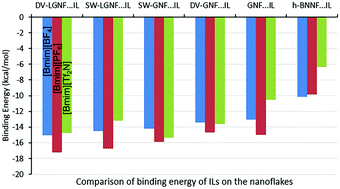The effect of defect types on the electronic and optical properties of graphene nanoflakes physisorbed by ionic liquids†
Abstract
Defect engineering and non-covalent interaction strategies allow for dramatically tuning the optoelectronic properties of graphene. Using ab initio density functional theory (M06-2X/cc-pVDZ), we find that the nature of defects on the graphene nanoflakes (GNFs) and the size of defective GNF (DGNF) surfaces affect the binding energy (ΔEb) of ionic liquids (ILs) and the UV-Vis absorption spectra of DGNF⋯IL complexes. Further, our results indicate that increasing the size of DGNFs affects the geometrical structure of the surfaces and increases the binding energy of ILs by about 10%. Analysis based on AIM and EDA shows that the interactions between ILs and DGNFs are non-covalent in nature (dispersion energy being dominant) and associated with charge transfer between the IL and nanoflakes. A comparison between the ΔEb values of ILs on DGNFs, GNFs, and h-BN nanoflakes (h-BNNF) shows that the presence of defects on the GNF surfaces increases the binding energy values as follows: DGNF⋯IL > pristine GNF⋯IL > h-BNNF⋯IL. Our calculations indicate that increasing the size of DGNF surfaces leads to a decrease in the HOMO–LUMO energy gap (Eg) of the DGNF surfaces. Orbital energy and density of state calculations show that the Eg of DV(SW)-GNFs decreases upon IL adsorption and their Fermi energy level is shifted depending on the type of IL, thus enabling better conductivity. Reactivity descriptors generally indicate that the chemical potential (μ) and chemical hardness (η) of nanoflakes decrease upon IL adsorption, whereas the electrophilicity index (ω) increases. The UV-Vis absorption spectrum of DV-GNF and SW-GNF shows four bands in the visible spectrum which correspond to π → π* transitions with the absorption bands of SW-GNF appearing at higher wavelengths than those of DV-GNF. The most intense absorption bands in DV-GNF (λ = 348 nm) and SW-GNF (λ = 375 nm) are associated with electronic transitions HOMO−1 → LUMO+2 and HOMO → LUMO+1, respectively. In addition, these absorption bands undergo a red-shift by both increasing the size of the DV(SW)-GNF surfaces and IL adsorption. We also observe that the energy gaps and absorption spectra can be altered by varying the defect types and the type of IL adsorbate, where the defect types affect the spectral shapes of the bands and adsorbates at the first absorption peak, thus having potential application for light-emitting devices.



 Please wait while we load your content...
Please wait while we load your content...